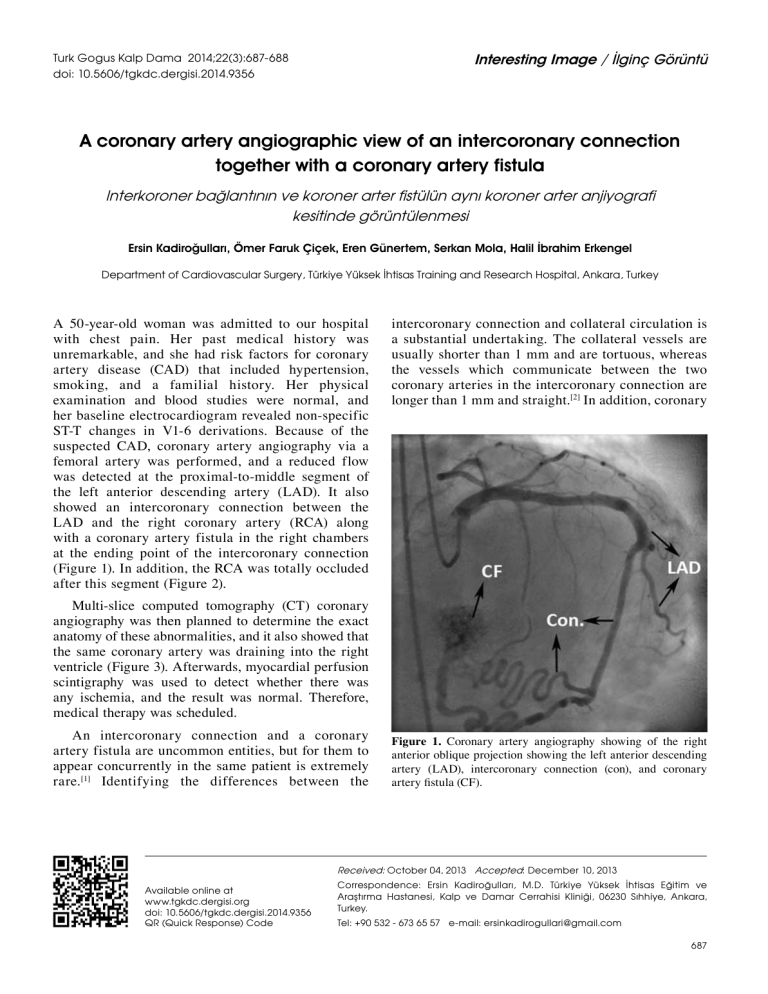
Interesting Image / İlginç Görüntü
Turk Gogus Kalp Dama 2014;22(3):687-688
doi: 10.5606/tgkdc.dergisi.2014.9356
A coronary artery angiographic view of an intercoronary connection
together with a coronary artery fistula
Interkoroner bağlantının ve koroner arter fistülün aynı koroner arter anjiyografi
kesitinde görüntülenmesi
Ersin Kadiroğulları, Ömer Faruk Çiçek, Eren Günertem, Serkan Mola, Halil İbrahim Erkengel
Department of Cardiovascular Surgery, Türkiye Yüksek İhtisas Training and Research Hospital, Ankara, Turkey
A 50-year-old woman was admitted to our hospital
with chest pain. Her past medical history was
unremarkable, and she had risk factors for coronary
artery disease (CAD) that included hypertension,
smoking, and a familial history. Her physical
examination and blood studies were normal, and
her baseline electrocardiogram revealed non-specific
ST-T changes in V1-6 derivations. Because of the
suspected CAD, coronary artery angiography via a
femoral artery was performed, and a reduced flow
was detected at the proximal-to-middle segment of
the left anterior descending artery (LAD). It also
showed an intercoronary connection between the
LAD and the right coronary artery (RCA) along
with a coronary artery fistula in the right chambers
at the ending point of the intercoronary connection
(Figure 1). In addition, the RCA was totally occluded
after this segment (Figure 2).
intercoronary connection and collateral circulation is
a substantial undertaking. The collateral vessels are
usually shorter than 1 mm and are tortuous, whereas
the vessels which communicate between the two
coronary arteries in the intercoronary connection are
longer than 1 mm and straight.[2] In addition, coronary
Multi-slice computed tomography (CT) coronary
angiography was then planned to determine the exact
anatomy of these abnormalities, and it also showed that
the same coronary artery was draining into the right
ventricle (Figure 3). Afterwards, myocardial perfusion
scintigraphy was used to detect whether there was
any ischemia, and the result was normal. Therefore,
medical therapy was scheduled.
An intercoronary connection and a coronary
artery fistula are uncommon entities, but for them to
appear concurrently in the same patient is extremely
rare.[1] Identifying the differences between the
Figure 1. Coronary artery angiography showing of the right
anterior oblique projection showing the left anterior descending
artery (LAD), intercoronary connection (con), and coronary
artery fistula (CF).
Received: October 04, 2013 Accepted: December 10, 2013
Available online at
www.tgkdc.dergisi.org
doi: 10.5606/tgkdc.dergisi.2014.9356
QR (Quick Response) Code
Correspondence: Ersin Kadiroğulları, M.D. Türkiye Yüksek İhtisas Eğitim ve
Araştırma Hastanesi, Kalp ve Damar Cerrahisi Kliniği, 06230 Sıhhiye, Ankara,
Turkey.
Tel: +90 532 - 673 65 57 e-mail: [email protected]
687
Turk Gogus Kalp Dama
Figure 3. Multi-slice computer tomography coronary
angiography showing the left anterior descending artery
(LAD), intercoronary connection (con), and coronary artery
fistula (CF).
Figure 2. Coronary artery angiography of the right anterior
oblique projection showing the right coronary artery (RCA).
artery fistulas often originate from the RCA or its
branches and drain into the right chambers of the
heart, and more than 90% of these fistulas drain into
the right ventricle.[3]
The appearance of an intercoronary connection
and a coronary artery fistula in the same coronary
artery angiography session is a rare occurrence, and
the patient's clinical status should be considered before
planning any treatment procedure.
Declaration of conflicting interests
The authors declared no conflicts of interest with
respect to the authorship and/or publication of this
article.
688
Funding
The authors received no financial support for the
research and/or authorship of this article.
REFERENCES
1. Latif SR, Truesdell AG, Drew T. Intercoronary connection
between the right coronary artery and left circumflex
artery in the absence of obstructive coronary disease and
collaterals. Med Health R I 2012;95:197-8.
2. Donaldson RF, Isner JM. Intercoronary continuity: an
anatomic basis for bidirectional coronary blood flow
distinct from coronary collaterals. Am J Cardiol
1984;53:351-2.
3. Schumacher G, Roithmaier A, Lorenz HP, Meisner H, Sauer
U, Müller KD, et al. Congenital coronary artery fistula in
infancy and childhood: diagnostic and therapeutic aspects.
Thorac Cardiovasc Surg 1997;45:287-94.
